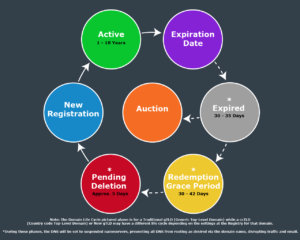This article discusses the following topics:
- Life Cycle of a Domain
- Phase 1: New Domain Registration
- Phase 2: Active Domains
- Phase 3: Domain Expiration
- Phase 4: Domain Redemption
- Phase 5: Pending Deletion
- Domain Transfers
Lifecycle of a Domain
 Every domain has a life cycle starting with its initial registration and ending with it being returned to the public for new registration. This life cycle can be extended indefinitely by regularly renewing the domain. Understanding your domain’s life cycle will help you know when a domain can be renewed and what is affected when the domain expires.
Every domain has a life cycle starting with its initial registration and ending with it being returned to the public for new registration. This life cycle can be extended indefinitely by regularly renewing the domain. Understanding your domain’s life cycle will help you know when a domain can be renewed and what is affected when the domain expires.
Phase 1: New Domain Registration
Domain registration policies and costs are governed by ICANN (Internet Corporation for Assigned Names and Numbers). To find out more about your consumer rights, go to www.internic.net.
The hosting company is not a requirement for the registrar. While buzinessware can host any domain name (as long as the DNS is pointed to us), we cannot register every domain.
When registering a new domain, be sure to provide a valid email address for your WHOIS, as you will be required to verify your WHOIS information via email. If verification is not received within 15 days, the domain name will be suspended.
If you register a domain directly with buzinessware, you could always contact buzinessware Support for domain-related help.
Order Validation for Domains
You will need to authenticate your domain order after finishing your domain registration with buzinessware. According to the ICANN 2013 Registrar Accreditation Agreement, this is an essential step in the domain registration process.
Phase 2: Active Domains
When a domain registration is successful, it becomes active for the duration of the registration. You might be able to register the domain for up to 10 years, depending on the registrar you choose.
You can at any moment do the following actions on a domain that you have registered while it is still active:
- Update your registration
- Moving your domain
- Update of the WHOIS
- Lock the domain
- Switch on domain privacy
- Modify the DNS
Phase 3: Domain Expiration
Your registration will be interrupted if you don’t renew your domain, at which point the registrar will modify your name servers. This indicates that it might take a few days before you notice your site is down, and that it might take a few more days to notice it is back online after you eventually pay to renew.
Prior to the expiration date, we will send emails to the Registrant Email address provided in the domain WHOIS. A second notification will be sent seven (7) days before the first one, which will be delivered thirty (30) days in advance of the expiration date. Immediately following the domain’s expiration, a final email will be sent.
Phase 4: Domain Redemption
The domain will begin its redemption period for about 30 days after it has expired for approximately 42 days and has not been renewed or placed on backorder during an auction. While the domain is under redemption, the current owner can renew it for the regular renewal charge plus a $250.00 redemption fee. If the domain is not restored during redemption, it will be marked as pending deletion.
Phase 5: Pending Deletion
The domain name will transfer to the Pending Delete phase for five (5) days if it is not redeemed during its redemption term. The domain name cannot be redeemed while it is in this condition, and after this time it will be released and open to public registration.